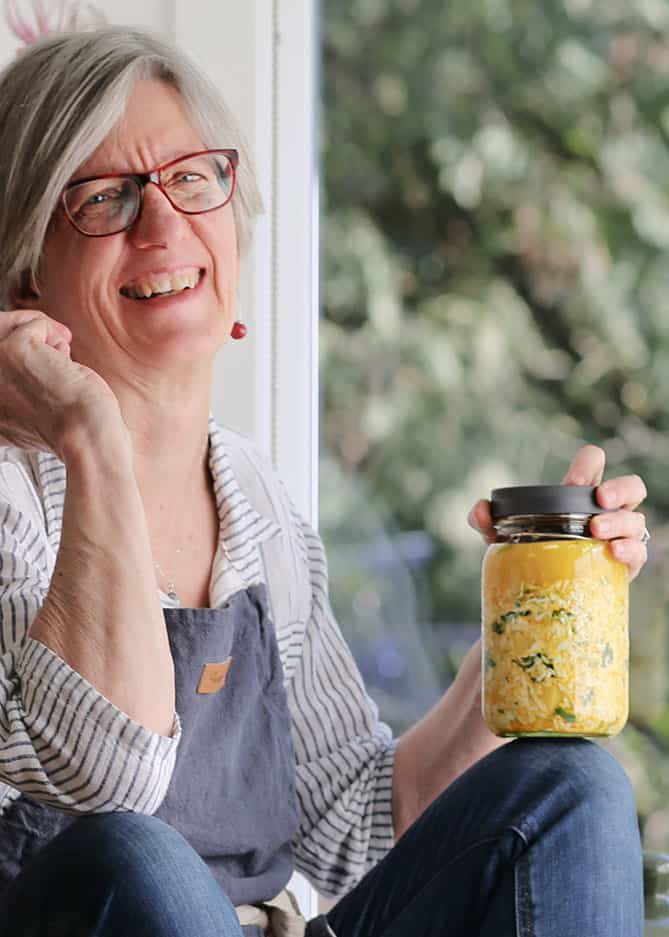Carrot Kimchi, or Tanggun Kimchi, is just one of over one-hundred types of kimchi. In this recipe, we take some of the seasonings from the various traditional kimchi recipes you may be familiar with and add them to shredded carrots.
This Carrot Kimchi recipe is based upon one I discovered in Kimchi: Essential recipes of the Korean Kitchen. It is shredded carrots mixed with leeks, radish, ginger, and garlic. And of course, fish sauce and Korean red pepper powder (gochugaru).
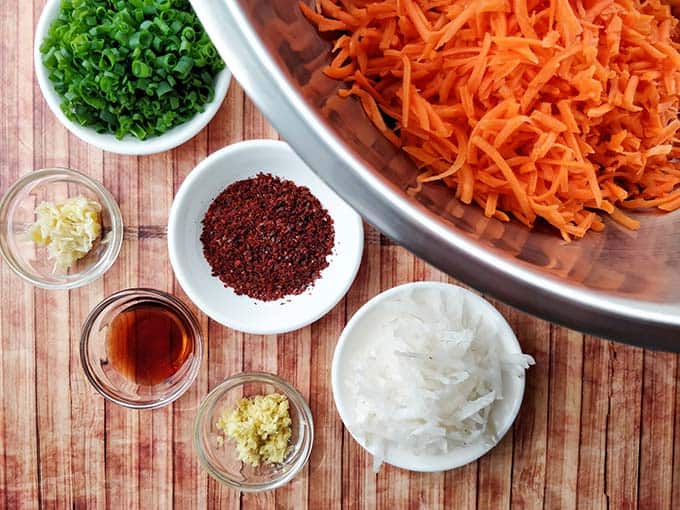
Kimchi goes international. This kimchi seems to be very popular in Russia, at least it is often requested by Russian tourists who visit Arirang. The carrots can also be eaten without leaving them to ferment, but of course you’ll then get a whole different flavour.
Once fermented, these flavor-packed shredded carrots can be enjoyed on their own, tossed into a salad, sprinkled over a rice bowl, added to a taco, mixed in with sauteed greens, or whatever else you dream up.
The best part about having yet another jar of fermented food taking a place of honor in your fridge?
It equals the ultimate fast food.
The work of preparing and seasoning the carrots has already been done. The mighty microbes have worked hard to transform the flavors, preserve the vegetables, and increase their nutritional value
Now, all you have to do is open the jar, grab a fork, and dig in.
Working with this recipe has been a fermentation game changer for me.
Instead of just pouring brine over prepared and seasoned carrots, the shredded carrots are first soaked overnight in a salty brine. They are then drained, a flavoring paste is mixed in, and the flavorful mixture is packed into a jar for fermentation. For now, I’ll call it the Brine & Drain technique.
I’m so happy to have experimented with this recipe for I hope that it will solve some fermentation challenges, such as:
Slimy beets and carrots.
Overactive jars of beets.
Brining and then draining your carrots is different than the recipe in Nourishing for Ginger Carrots in which shredded carrots and ginger are salted and massaged to create their own brine (as in making sauerkraut). Very rarely did this recipe work for me. I invariably ended up with slimy carrots that I had to toss. Recipe for Ginger Carrots from Fermented Food Lab.
I then switched to packing a jar with shredded carrots and then pouring brine over. They ferment just fine, but if you fill the jar too full, it will overflow during the initial active phase and you also end up with more brine than you know what to do with. I’ve yet to come up with flavors that seem to work and stay with the carrots.
Time will tell. I’ll need to experiment with more batches to fine turn salt and fermentation length.
Carrot Kimchi Recipe Tips & Notes
Specialty Items to Buy Online
Goghugaru
This recipe calls for gochugaru, a Korean red pepper powder used in many traditional Korean kimchi recipes to add a rich—but gentle—spiciness. I cover its many flavorful benefits in detail in this post.
Fish Sauce
Fish sauce is a liquid condiment prepared from fermented anchovies and salt. My favorite brand is Red Boat. It is used as a staple seasoning in the cuisines of Southeast and East Asia, particularly Indonesian, Burmese, Cambodian, Filipino, Thai, Lao, and Vietnamese AND is a key ingredient in many styles of kimchi, including Carrot Kimchi.
Salt for Brining and Fermenting
I use pickling salt for the brine and Himalayan pink salt in the seasoning paste.
Recipe Notes
Salt Test
Just like sauerkraut, a good kimchi contains the right amount of salt. I have you prepare a 5% brine when soaking the shredded carrots, but to make sure it’s right, it’s important to taste the carrots after salting.
If they are very salty—they will taste like you just swallowed a mouthful of seawater—the carrots need rinsing. If the carrots taste like a salty potato chip, they’re probably just right. If they taste a bit bland, they are probably undersalted, add additional salt when seasoning. This is also covered in the recipe.
Can I Make a Vegetarian Batch of Carrot Kimchi?
Yes. Substitute 1 tablespoon of any one of these suggested substitutions (miso, coconut aminos, soy sauce, vegemite, marmite) in place of the fish sauce.
Variation: Ginger Carrots
When developing this recipe, I did also ferment a batch seasoned with ginger, lemon zest, and lemon juice. Feel free to do likewise.
Add 1-2 tablespoons of grated ginger, and the zest and juice of one lemon. You’ll want to test salt levels BEFORE adding the lemon because its strong acidity makes it difficult to unearth any salt taste.
Salt By Weight: Measure Salt Like a Pro
In this recipe, we soak the shredded carrots overnight in a 5% brine.
If you have a digital scale that reads in Baker’s Percentage—as my favorite scale does (as I recommend here)—then follow the directions at the end of this post to easily calculate the salt needed for however much water you add to your carrots.
Once you get the hang of using Baker’s Percentage, you’ll wonder how you ever fermented without it.
The Five Tools I Grab Every Time I Ferment Something
![Carrot Kimchi [Tanggun] ready for fermentation. | MakeSauerkraut.com](https://www.makesauerkraut.com/wp-content/uploads/2019/04/carrot-kimchi-9-300x300.jpg)
Carrot Kimchi [Tanggun] Recipe
INGREDIENTS
Carrot Base
- 2 pounds (1 kg) carrots
Carrot Brine (5%)
- 3 tablespoons (50 gm) pickling salt
- 4 cups (1 liter) chlorine-free water
Carrot Kimchi Seasoning Paste
- 1/4 cup (20 g) shredded leeks, or, green onions, finely sliced
- 1/2 cup (40 g) shredded daikon, or, other radish
- 1 tablespoon (15 ml) peeled and finely grated ginger
- 1 teaspoon (5 ml) minced garlic
- 1 tablespoon (15 ml) Korean red pepper powder (gochugaru), Korean red pepper powder
- 1 tablespoon (15 ml) fish sauce, For vegetarian, omit or substitute soy sauce
- 1 teaspoon (5 ml) iodine-free salt (fine-grain)
Saltiness Check
- 1+ teaspoon (5 ml) iodine-free salt (fine-grain)
INSTRUCTIONS
- CUT & SOAK CARROTS. (Day before)Your shredded carrots will soak in a salty brine for 24 hours and then be drained the following day.Peel and shred carrots and place in a large bowl. Mix brine and pour over carrots. NOTE: If you have a digital scale that reads in Baker's Percentage, follow instead the "Measure Salt Like a Pro" directions above this recipe. Leave brine carrots out on your counter to soak for 24 hours.
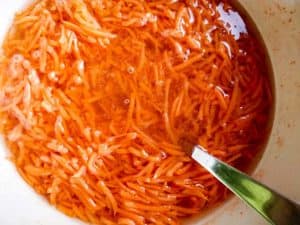
- DRAIN CARROTS (24 hours later)Use a colander to drain your shredded carrots. Leave them in your sink to finish draining while you prepare the seasoning paste.
- PREPARE CARROT KIMCHI SEASONING PASTEUse a grater box to shred leeks and radish and place in a small bowl along with your finely grated ginger and minced garlic. I substituted green onions for this batch.Add gochugaru (Korean red pepper powder), fish sauce, and 1 teaspoon salt. Mix well.
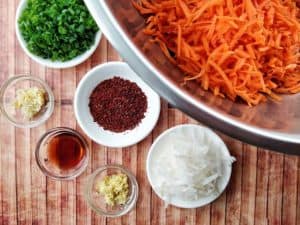
- CHECK THE SALTINESS OF THE CARROTSA good kimchi contains the right amount of salt. You have to taste the vegetable after draining and then adjust, if necessary.Taste your drained carrots.If they are very salty—tasting like you just swallowed a mouthful of seawater—the carrots need rinsing. Rinse until they taste just slightly too salty.If the carrots taste like a salty potato chip, your salt levels are just right. If the carrots taste a bit bland and you don't detect much saltiness, wait until you mix in the seasoning paste, at which time you'll add more salt.
- MIX PASTE WITH CARROTSAdd Carrot Kimchi seasoning paste to the drained carrots and mix well. Taste.If necessary, add 1/2 teaspoon of iodine-free salt and mix again. Add salt until your Carrot Kimchi tastes just a tad too salty.
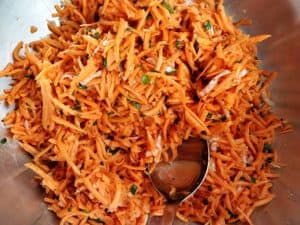
- PACK INTO JARGrab a handful of your beautiful carrot kimchi and pack into your jar. To cut down on the mess, I hold the jar with one hand and pack the jar using my other hand.Leave 1-inch (2-3 cm) of headspace for expansion during fermentation. Use a damp towel to clean the rim of your jar and then weigh down your kimchi with your preferred fermentation weight. Loosely, to allow gases to escape, screw on a lid. Or, use your airlock lid of choice.
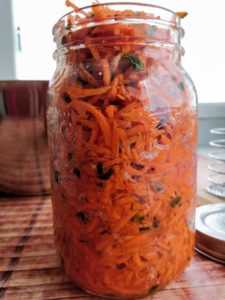
- FERMENTLeave to ferment at room temperature for 3-5 days. Move to your fridge to slow down fermentation. Flavors will meld and evolve over time. I don't let these ferment too long since they are prone to yeast growth.
- ENJOYYou now have a jar of the ultimate fast food "at the ready." Grab a forkful—or two—of it to effortlessly transform your meals.
Notes and Tips
- To make a vegetarian batch of Carrot Kimchi, substitute 1 tablespoon of any one of these suggested substitutions (miso, coconut aminos, soy sauce, vegemite, marmite) in place of the fish sauce.
- You may season with ginger, lemon zest, and lemon juice. Add 1-2 tablespoons of grated ginger, and the zest and juice of one lemon. You’ll want to test salt levels BEFORE adding the lemon because its strong acidity makes it difficult to unearth any salt taste.
How to use the MyWeigh KD8000 scale to Calculate Salt
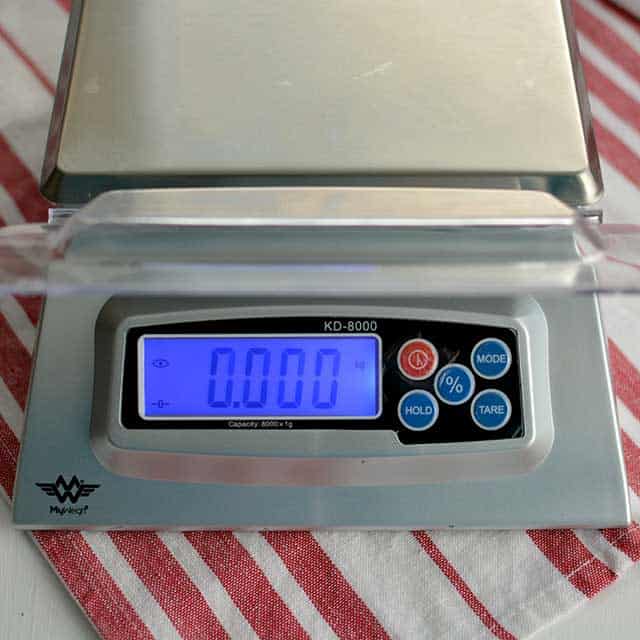
Turn on Your Scale
On the Myweigh KD800 scale, press the red [On/Off] Key to turn on the scale. It will take a few seconds for the scale to automatically count down from 99999 to 00000.
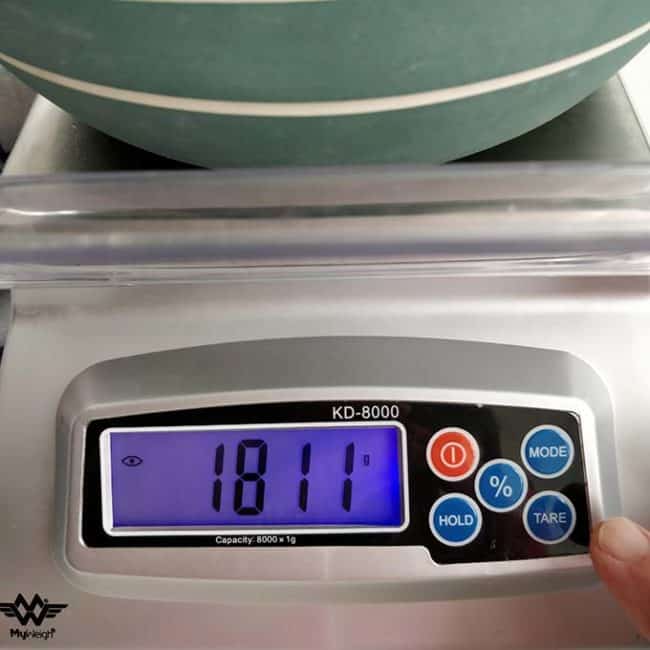
Place Bowl of Carrots on Scale
Place your bowl of shredded carrots on the scale and press the [MODE] button until it measures in grams [g].
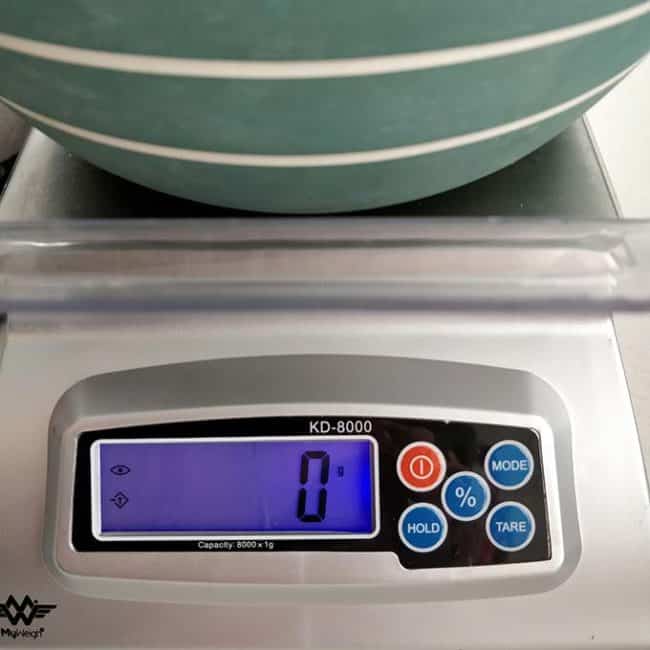
Tare Your Bowl & Carrots
Press the [TARE] button to remove the weight of the carrots and bowl. The scale will read “0”
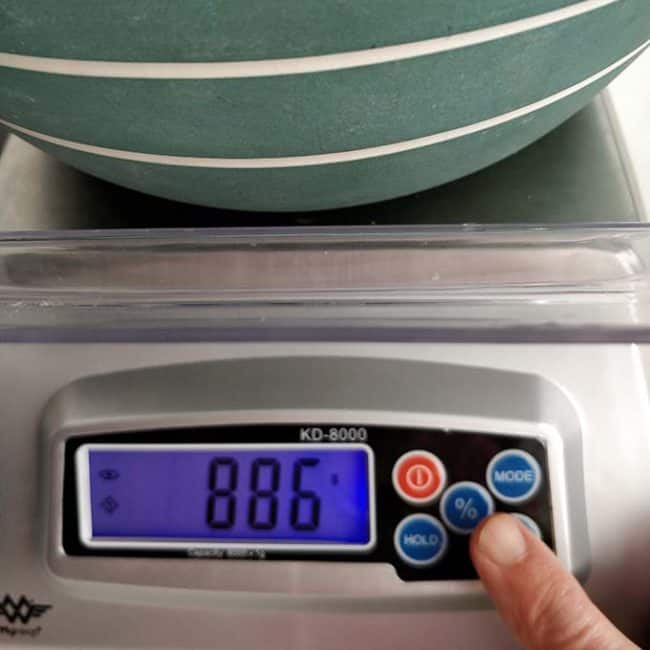
Add Water & Return Bowl to Scale
Remove the bowl and add enough water to cover the shredded carrots.
Return the bowl to the scale.
The display will indicate how many grams of water you added.

Switch to Baker’s Percentage
Press the “%” key. “100.0” will display on the scale.
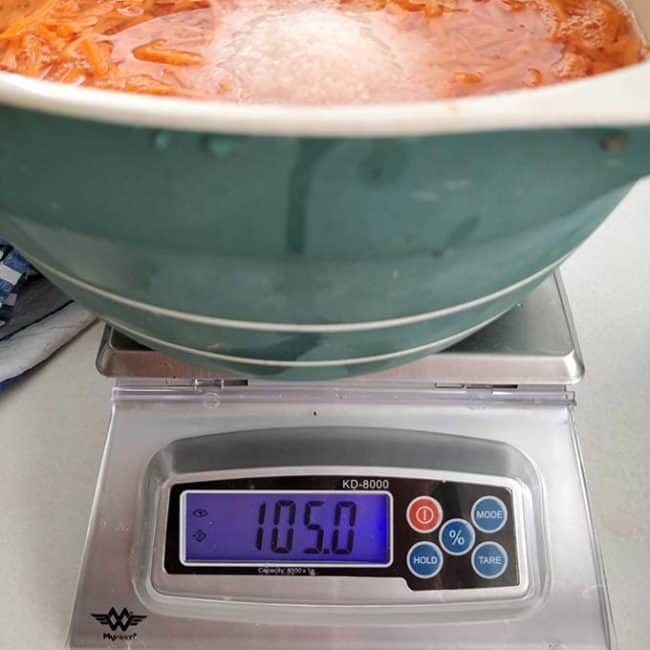
Add 5% Salt by Weight
Slowly sprinkle salt into the bowl until the numbers read “105.0” There’s your 5% brine! Sweet and Simple!
![Carrot Kimchi [Tanggun] ready for fermentation. | MakeSauerkraut.com](https://www.makesauerkraut.com/wp-content/uploads/2019/04/carrot-kimchi-9-650x488.jpg)
Last update on 2024-07-26 / Affiliate links / Images from Amazon Product Advertising API

![Bowl of carrot Kimchi [Tanggun] ready for fermentation. | MakeSauerkraut.com](https://www.makesauerkraut.com/wp-content/uploads/2024/05/carrot-kimchi-669x1004.jpg)

 This post may contain affiliate links which won’t change your price but will share some commission.
This post may contain affiliate links which won’t change your price but will share some commission.![Carrot Kimchi [Tanggun] ready for fermentation. | MakeSauerkraut.com](https://www.makesauerkraut.com/wp-content/uploads/2019/04/carrot-kimchi-PLP-394x1024.jpg)
